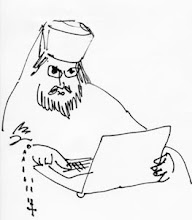 A couple of weeks ago I happened to mention in a post my interest in a newish book by Archimandrite Placide (Deseille), whom many of you may know from his conversion story in Fr Alexander Golitzin's The Living Witness of the Holy Mountain Contemporary Voices from Mount Athos. (The original French of the text is here.) Perhaps because I'm not a convert myself, I'm not generally a fan of the genre of conversion story, but I found Fr Placide's account too charming to resist and have long wanted to hear more from him. Fr Placide is abbot of the Monastery of St Anthony the Great in Saint Laurent in Royans and is a sometimes professor of patristics at the St Serge Institute in Paris. He is the author or translator of nearly a dozen books in French, including a translation of the Psalter.
A couple of weeks ago I happened to mention in a post my interest in a newish book by Archimandrite Placide (Deseille), whom many of you may know from his conversion story in Fr Alexander Golitzin's The Living Witness of the Holy Mountain Contemporary Voices from Mount Athos. (The original French of the text is here.) Perhaps because I'm not a convert myself, I'm not generally a fan of the genre of conversion story, but I found Fr Placide's account too charming to resist and have long wanted to hear more from him. Fr Placide is abbot of the Monastery of St Anthony the Great in Saint Laurent in Royans and is a sometimes professor of patristics at the St Serge Institute in Paris. He is the author or translator of nearly a dozen books in French, including a translation of the Psalter.The book I mentioned in my post is entitled Orthodox Spirituality and the Philokalia. Due to the kindness of a reader (you know who you are), a copy was sent to me, and I am hungrily consuming it – perhaps too quickly for the subject matter, it should be said. The book is made up of three parts: a concise overview of the monastic tradition up to and including the creation of The Philokalia; then a long thematic anthology of representative selections from the Fathers focusing on theosis and hesychastic prayer; and a concluding chapter with a historical narrative tracing the influence of the Philocalic tradition in both East and West. I'll comment on each of these three parts separately.
Following a brief introduction, Fr Placide offers a narrative covering all those Fathers and ecclesiastical writers whom he views as being part of the great Philocalic tradition, from the origins of monasticism to the publication of The Philokalia. This is what he covers:
One: The Origins of Hesychasm. First, the Age of the Desert Fathers: St Anthony the Great, the Desert Fathers and the Church Fathers, Evagrius of Pontus and the Alexandrian Tradition, St Macarius of Egypt, St Diadochus of Photike, St Isaiah the Anchorite, St Mark the Ascetic.
Second, The Expansion of Hesychasm: the monks of Sinai, spiritual authors of the Syrian language.
Third, Theology and Spirituality in Byzantium: St Maximus the Confessor and Thalassius of Lybia, St Symeon the New Theologian and Nicetas Stetathos, St John and St Peter of Damascus.
Fourth, Athonite Hesychasm: St Nicephorus the Solitary, Theoleptus of Philadelphia, St Gregory Palamas, Kallistos Angelikoudes, St Callistus I and St Callistus and Ignatius of Xanthopoulos; St Mark of Ephesus; Hesychasm in the Balkans and in Russia.
Two: The Epoch of the Philokalia: St Paisy Velichkovsky, the Kollyvades of Mount Athos and the Greek Philokalia.
The writing is clear and concise, the author's voice sympathetic yet critical. It's wonderfully refreshing to read a scholarly treatment which speaks both with erudition and with deep piety and veneration for its subject matter. Particularly interesting is his treatment of spurious works. Speaking of the works of St Anthony the Great included in the Philokalia (shunted into an appendix in the English edition), Fr Placide writes:
The writing is clear and concise, the author's voice sympathetic yet critical. It's wonderfully refreshing to read a scholarly treatment which speaks both with erudition and with deep piety and veneration for its subject matter. Particularly interesting is his treatment of spurious works. Speaking of the works of St Anthony the Great included in the Philokalia (shunted into an appendix in the English edition), Fr Placide writes:
The first author represented in the Philokalia is St. Antony the Great, venerated by all of Christian tradition as "the Father of monks." It matters little that modern criticism points out the apocryphal character of the treatise attributed to him in this collection. The name of Antony alone has symbolic value.So far as I've read, I can give the book a ringing endorsement. Tomorrow I'll post on part two (Thematic Anthology).









No comments:
Post a Comment